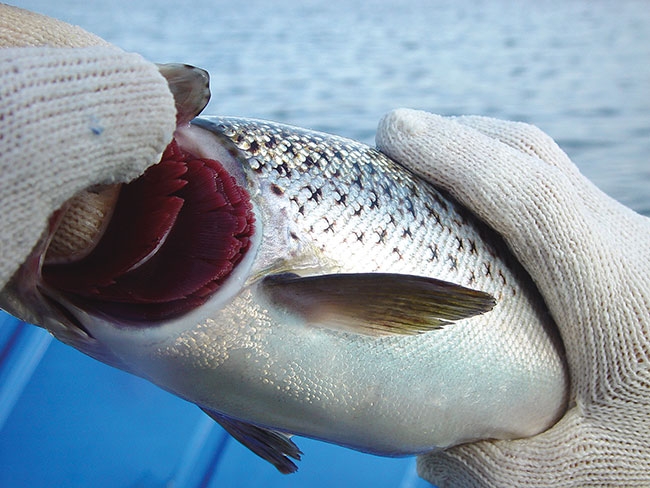
Study reveals ideal condition for most effective treatment for amoebic gill disease
January 29, 2019
By Ruby Gonzalez
Freshwater is used to treat amoebic gill disease (AGD) in salmonids but when it poses a logistical challenge, hydrogen peroxide treatment may be used. The effectiveness of the results, however, depends on the water temperature.
 Checking an Atlantic salmon for amoebic gill disease. Hydrogen peroxide treatment for the disease is most effective when water temperature is at 8°C Freshwater is used to treat amoebic gill disease (AGD) in salmonids
Checking an Atlantic salmon for amoebic gill disease. Hydrogen peroxide treatment for the disease is most effective when water temperature is at 8°C Freshwater is used to treat amoebic gill disease (AGD) in salmonidsThe study, Effect of hydrogen peroxide as treatment for amoebic gill disease in Atlantic salmon (Salmo salar L.) in different temperatures, estimated the effectiveness of different doses of hydrogen peroxide to treat AGD-infected Atlantic salmon at a range of seawater temperatures. Researchers Martinsen K.H., Thorisdottir A., Lillehammer M. of NOFIMA and VESO Vikan laboratory found that the treatment was most effective at a low temperature of 8°C, which was tested with hydrogen peroxide doses of 1.5, 1.8 and 1.2 g/L.
Treatments were performed in tanks with aerated seawater (33‰ ± 2‰). Doses were decreased as the temperature increased.
At 8°C, subsequent development of AGD infection was delayed substantially by roughly 8.5 weeks, compared to 1.7 weeks at 12°C and 1.5 weeks at 17°C.
AGD is a pathogenic disease in salmonids caused by Neoparamoeba perurans. It attacks the respiratory system of the fish, causing lesions or white and gray mucoid spots on the gill surface, which lead to reduced gill function. Infected fish are lethargic and exhibit reduced swimming activity, increased respiratory rate, reduced feed intake and reduced growth.
The development of the disease is dependent on seawater temperature and salinity, making AGD a problem for the farmed salmon industry in areas with high salinity and seawater temperatures.
“Hydrogen peroxide as treatment for AGD was shown to be successful for all combinations of doses and temperatures tested. The gills partially recovered following treatment and further development of the disease was delayed. However, all groups developed the disease again after treatment, suggesting that fish were not cured,” the authors wrote.
The same was observed in the freshwater treatment.
“Both freshwater and hydrogen peroxide treatment may cause mortalities as the fish is already weakened by the disease and the treatment itself can cause additional stress to the fish. Neither treatment seems to be fully effective, as AGD reappears in treated fish, both under natural and controlled experimental conditions.”
They concluded, “repeated treatments are, therefore, necessary, sometimes several times during a life cycle.”
“Furthermore, it is important for both economic considerations and fish welfare that the method used is both effective and gentle on the fish,” said the authors.
Advertisement
- Red Lobster’s Horace Dawson joins GSA board of directors
- Stronger America Through Seafood reaching out to seafood community stakeholders





